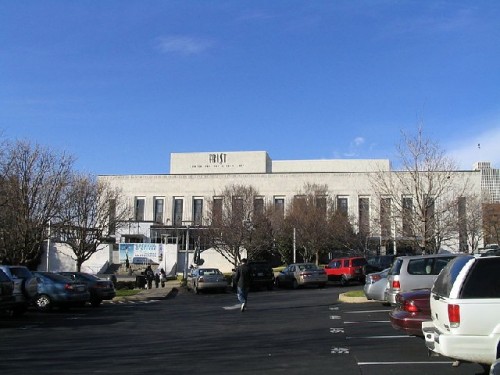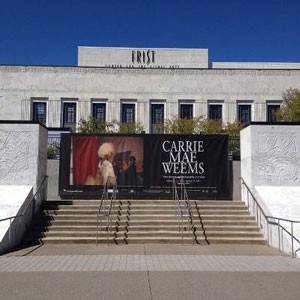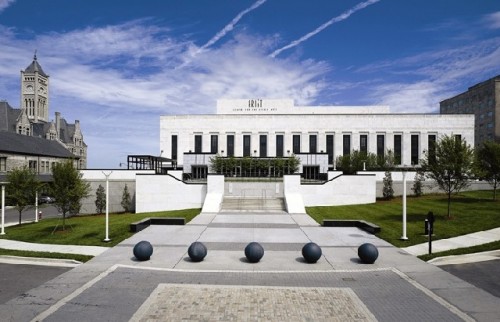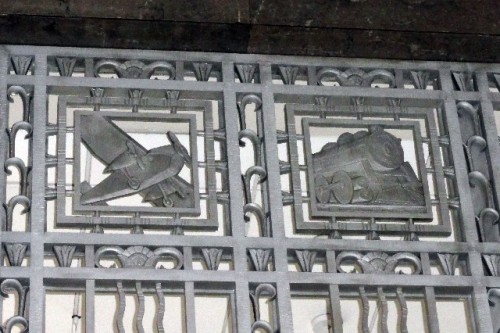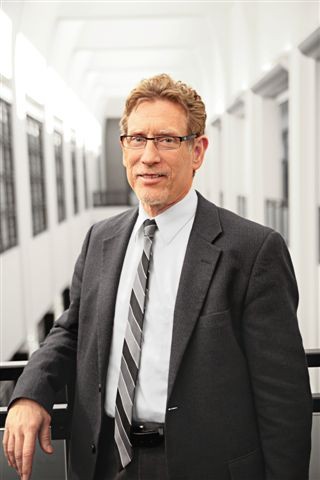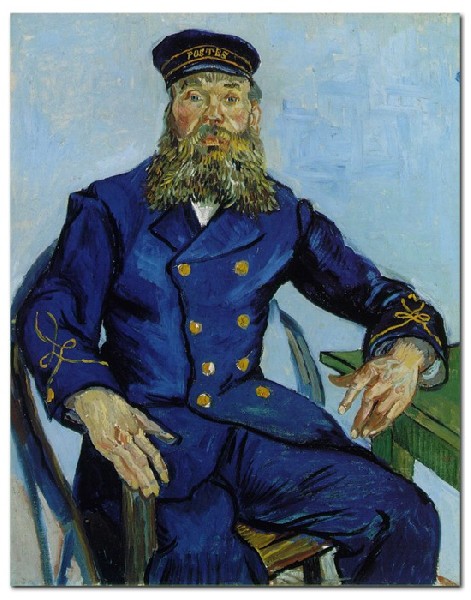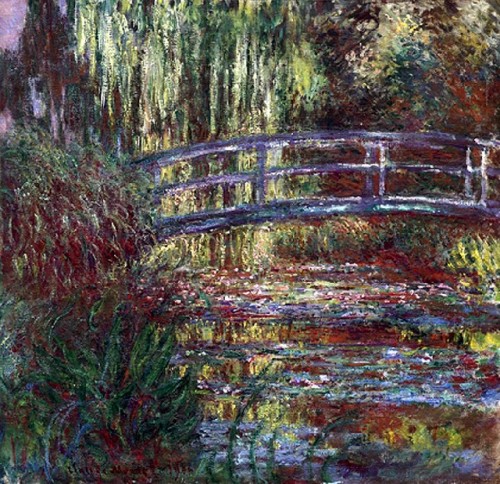The Frist Center for the Visual Arts
Nashville's Art Deco Kunsthalle
By: Charles Giuliano - May 08, 2014
The Frist Center for the Visual Arts is housed in a white marble building that was built in the 1930s to serve as Nashville's main post office. Designed by Marr & Holman Architects in an art deco style it was built in 1933-34.
When a new main post office was built near the airport in 1986, the historic facility became a downtown branch using only a small portion of one floor.
In the early 1990s Thomas F. Frist, Jr., and his family, through the charitable Frist Foundation, proposed a downtown art museum. In 1999 the City of Nashville acquired the building from the U.S. Postal Service paying $4.4 million. The city contributed $15 million toward renovation of the building, and the Frist Foundation and Frist family contributed $25 million for the renovation and to start an endowment for the art museum. The city owns the building, but granted the Frist Center a 99-year lease for $1 per year. A renovated post office branch was opened in the basement in 1999.
The non collecting museum, or kunsthalle, opened in April 2001. The Frist consists of 24,000 square feet of gallery space presenting from ten to twelve annual exhibitions. Some are organized by a curatorial staff of three while others are traveling exhibitions derived from relationships with major museums in the U.S. and Europe.
While Nashville is known as the Music City exhibitions of the Frist have reconfigured the city as a major destination for the visual arts in the region.
During a recent visit to the museum we met for lunch with Ellen Pryor, the director of marketing and media relations and chief curator Mark Scala. We then toured three exhibitions Looking East: Western Artists and the Allure of Japan from the Museum of Fine Art, Boston, Goya: The Disasters of War and Steve Mumford’s War Journals 2013-2013 which was curated by Scala.
Having grown up with the MFA it was interesting to see familiar works in a different context. In particular there was a generous selection of prints from the museum’s vast collection. The icing on the case was the number of major French impressionists works including a late Monet painting of the Japanese bridge over his pond of lilies at Giverny. It was not immediately evident why van Gogh’s The Postman Roulin was included but it was surely a highlight and drawing card for visitors.
Charles Giuliano This is our first visit to the Frist. Tell me about yourself.
Mark Scala I was born and raised in Pittsburgh and went to Virginia Commonwealth University. I love being in the South and have made a career here. I’m the chief curator for the Frist Center for the Visual Arts. I introduce audiences to experiences they wouldn’t have had otherwise. My field is contemporary art although at the Frist we are an encyclopedic kunsthalle. We have three curators and don’t have the luxury of only concentrating on your field of specialization. The others are Katie Delmez who also covers modern and contemporary art. Her most recent success was the Carrie Mae Weems retrospective. Currently it’s at the Guggenheim.
CG Ed Rubin posted his review on our site.
MS He is a great friend of our museum. The third curator is Trinita Kennedy. Her specialty is Renaissance art. She was at the Metropolitan Museum of Art where she worked on the special exhibition Venice and the Islamic World. So she is familiar with Islamic art as well. This fall she opens Sanctity Pictured: The Art of the Dominican and Franciscan Orders in Renaissance Italy.
(It explores the role of the two major new religious orders in the revival of the arts in Italy during the period 1200 to 1550. The exhibition presents drawings, illuminated manuscripts, liturgical objects, paintings, prints, printed books and sculptures drawn from the collections of major American and European libraries and museums, including works of art from the Vatican Library and Vatican Museums that have never before been exhibited in the United States.)
Her thesis is that because of their sponsorship of art the Dominicans and Franciscans helped to develop what we define as Renaissance art. That included paintings, altar pieces and commissions for architecture. It’s a very different and exciting project for us. It helps that the name of the current Pope is Francis.
CG Perhaps he will attend the opening.
MS As I mentioned all of the curators have to step outside their areas of specialty and a few years ago she curated the exhibition of work by Lalla A. Essaydi (She grew up in Morocco, and lived in Saudi Arabia for many years. She now lives in New York City. Essaydi received her MFA from the School of the Museum of Fine Arts/TUFTS University in May 2003.)
CG I knew her when she was at the Museum School. At Tufts I saw her thesis show and she also exhibited at the Williams College Museum of Art. I am sure your exhibition was a great success.
MS Stepping outside your specialty as we do here you get to immerse yourself in work and have experiences you might not otherwise have had. For example I managed several exhibitions of Egyptian antiquities.
CG After college my first job was in the Department of Egyptian Art at the Museum of Fine Arts so I am fascinated by your projects.
MS Typically we take on shows that others have organized. Someone on our staff will learn as much as possible about the works which was the case for both of these Egyptian exhibitions. I didn’t organize the shows. One was called The Quest for Immortality. It was organized in Denmark. As curatorial liaison you absorb the material and try to assist the experience for visitors. We had great visitation particularly from young people. This was the first time in Nashville for school children to see first rate Egyptian antiquities.
CG When I was a kid, probably about eight or nine, an uncle visited from New York and took my sister and me for our first visit to the MFA. That night my parents asked what I saw. I said that it was exciting to see mummies and samurai swords. Who knew that I would get to actually work there.
MS The Frist has now been open long enough that we get that response. Young people now in college tell us how visiting on a school trip got them excited in a way that they still remember.
CG In our travels we visit a lot of regional museums. Often they have small and limited collections. But in its role as a kunsthalle, with no permanent collections, it is interesting that the Frist is able to present world class exhibitions. That must be having a real impact on your audience. Just what is the geographic and demographic target for the museum’s programming and how do you measure its reception?
Ellen Pryor It changes with every exhibition. When we do Sanctity Pictured in the fall, for example, the exhibition will not travel. We are its only venue. People will come here from all over the world to see that exhibition. We had an exhibition like that last summer and people visited from all over the United States. It was an art deco automobile show which was a kind of gallery time period expression of the design of the builing.
Day to day we were formed to serve the families and children of Nashville. That’s always our primary audience. Beyond that we look at an audience that can get here and back within a day. That’s a range of 200 miles. So that’s routinely Atlanta, as far north as Louisville, or south to Birmingham. But when we have something like the Egyptian show with no stops between here and San Francisco, or a show that’s only here, we get people from everywhere.
CG The Sanctity Pictured exhibition sounds incredible. Can you give us a sense of some of the work that will be on view?
MS You would really have to talk with Trinita about that as it is out of my field.
There is the challenge for any museum which is outside the major cities. It is very difficult to get major works. As a non collecting museum we don’t have a quid pro quo with other museums. We don’t have an 8 million audience surrounding us.
That said, when you have an idea that people respond to then the result is that the Vatican, Getty, and other major museums are lending. They participate because they believe the show is really contributing to scholarship in the field. That’s what we bring to the table.
CG That raises an interesting issue. In the Boston Globe the critic Sebastian Smee has commented that often visitors to the MFA, for long periods of time, are unable to view a number of the museum’s greatest and most popular works. ("Masterpieces on Loan Leave MFA's Walls Lacking")
That has been particularly true under the director Malcolm Rogers. He has been criticized for regarding the collection as an equity resource through overly extensive loans. The question has been raised of whether the MFA will cut back on its extensive loans under a new director.
MS We have heard that criticism become some of those MFA loans have been to us.
CG To be crass the MFA and other major museums have been cashing in on their collections as a means of balancing the books during economic hard times.
EP These special exhibitions also serve as a calling card for the lending museums. If you have experienced that visual hors d’ oeuvre you are likely to want to see more. So there are two sides of that. The individual who got the Frist rolling was a banker. In banker’s terminology there are what they call non performing assets. They are assets held by an organization which are not performing or earning any income.
His idea was that there are museums all over the world sitting on huge collections. They have the potential to earn money. That’s not the only reason but that notion was very much woven into the founding of the institution.
MS You made the point of visiting so many museums that have mediocre collections. There was no interest ever in our having a mediocre collection. People don’t come back time and time again to see mediocre art. The idea was let’s bring the best that we can.
Astrid Hiemer In the Berkshires we have an example of that. During renovation works from the Clark Art Institute collection went on tour to eleven museums around the world. Three continents. We learned how complicated that is sending four people to each venue when the works arrived and departed. The collection was sent on four airplanes with the works assigned according to value so as to minimize a potential loss.
CG You must have an enormous budget to pay for these expensive exhibitions. What is the exhibition budget?
EP We don’t discuss that.
MS Enormity is a matter of perspective. We don’t have the exhibition budget that the MFA Boston has. We do ten to twelve exhibitions a year. Right now we have a show from the MFA Boston Looking East: Western Artists and the Allure of Japan. That was a big budget item for us. On the other hand we have Goya’s Disasters of War and a related exhibition of works by Steve Mumford which was fairly reasonable for us. So it doesn’t always cost top dollar in order to bring the very best of any type of work.
CG What is the annual attendance?
EP Year in and year out it’s 220,000 to 250,000. There’s no usual for us because we’re always changing. It varies by season and in lots of ways. So there’s no way to predict. Just when we think it’s figured out something happens.
CG What’s the annual budget?
EP Around $12 million.
MS That’s good for this region.
EP We have a modest endowment. We’re young. The building is owned by the city of Nashville. We acquired the building in November, 1999 from the US Postal Service. The city paid for the building and renovated it to core standards. That meant if it was going to be turned into condos or a hotel. That’s what they paid for anything over and above that including security, environmental control, all of the hundreds and hundreds of things that had to be done including hiring a staff, all of that, was assumed by the Frist Foundation. Thomas S. Frist, Jr. is our first benefactor.
The Frist name is familiar to a lot of people because of Senator Bill Frist who was the majority leader of the US Senate. Their father was a prominent physician in Nashville. He was one of the founders of Hospital Corporation of America. It was the first for profit hospital organization. It has grown and become very successful. Their family is located here. Ken Roberts the banker I was talking about was head of the Frist Foundation back in the 1990s.
There was a community visioning process looking toward the year 2000. What did Nashville need and want to be? Out of this emerged ideas for the 21st Century. One of these was the need for a major museum. There were places to see art but not major exhibitions.
CG What is the profile for giving in Nashville? I would imagine there is a lot of tugging on the pockets of a limited number of people.
EP We have foundation and government support including the Tennessee Arts Commission and the National Endowments. We have great sponsors and a terrific membership. We’re not unlike other cities our size. The Frist Foundation supports a lot of activities. We are not the only beneficiary. There are generous families and if you travel around the city you will see their names.
CG Why did you take this job? What were the incentives and challenges?
MS I came here from a small museum in Virginia. It’s now called the Taubman Museum. I had done a lot of contemporary and American exhibitions. It was a profile they were looking for when they engaged me. I refer to myself as an art evangelist. I love working with art that’s going to have a transformative impact on audiences. I get to do some of my own projects.
I did a show called Paint Made Flesh. (The exhibition included works by Pablo Picasso, Francis Bacon, Lucian Freud, Willem de Kooning, Alice Neel, Leon Golub, Philip Guston, Eric Fischl, Georg Baselitz, Jenny Saville, Wangechi Mutu, John Currin, Cecily Brown, Daniel Richter, and others.) It was an exhibition about very rich oil paint within a series of exhibitions on the body. They have been well received and gratifying because of the scholarship which I can do. I work with great contributing writers for the catalogues. There aren’t that many places that let you do things like that.
CG Through our visits to New York galleries and most contemporary exhibitions, with the exception of those featuring Chinese artists, I feel apathetic. There is so much out there now with the global biennials and art fairs. In this environment what compels you? What are you looking for as potential exhibitions?
MS I go to Art Basel and the Armory Show. I spend a lot of time in New York. In many ways I have the same response that you have. I contend that at any given time or place 90% of the art being produced is not that memorable. The task is to find that increment that stands out.
CG Can you describe what’s the right fit for your museum and community?
MS It depends on what’s out there. This summer we have Maira Kalman a wonderful New York illustrator. Her paintings are very much like David Hockney or Matisse but quirky like Saul Steinberg in their sense of humor. That’s one approach. Then there’s U Ram Choe, a Korean artist, who creates large kinetic machines. They are playful riffs on bio genetic engineering. There’s a great sense of showmanship.
When you’re an evangelist you go for the show. You go for what’s going to connect with people in a visceral way. In an emotional and intellectual way. So it’s really going to connect with people.
AH Where did you see Choe?
MS I saw him in the Crow Collection in Dallas. (The Trammell & Margaret Crow Collection of Asian Art is a museum dedicated to the arts and cultures of China, Japan, India and Southeast Asia.) I had seen a few things but when I saw a whole show of his work I thought this is really going to resonate with people.
CG Years ago I interviewed Stephen Prokopoff who was then the director of Boston’s ICA. I asked him about contemporary artists with the potential to draw significant audiences to the museum. He surprised me by answering that there weren’t any or very few.
About a decade ago I asked Michael Conforti when the Clark would change from its formula of French Impressionism and 19th century art exhibitions. He talked about how the well was running dry as audiences grew older. Since then the museum has shifted into modernism and two summers ago in their detached space showed El Anatsui. When it reopens this summer Conforti anticipates more modern and contemporary art in their mix. They are also deciding how to build out and program space leased long term on the nearby Mass MoCA campus. We seem to be in the midst of a paradigm shift for special exhibitions.
Your museum organized the Carrie Mae Weems traveling exhibition. How was it received and what does it represent in terms of future programming for the Frist? We assume that she was not a familiar artist for your audience.
MS Of course a lot of what you do is marketing and education. You have to help people to understand how important an artist is. The exhibition exceeded our expectations in terms of attendance. It wasn’t lines out the door but we didn’t expect that. It was an exhibition of work by a very serious artist. Like all museums we have dozens of audiences and what appeals to some does not to others. Michael Conforti’s point about Monet is correct. We try to have a balanced program. There’s an upstairs and downstairs space so we can show a variety of things.
EP We are an educational institution and it’s our mission to educate people in art. This is not a town that has had that tradition. There are not many places in the South that have. When we had Carrie Mae Weems we also showed Norman Rockwell. So the dialogue between those two galleries talked about what it means to be an American. People regard Rockwell as simplistic and idealistic. You look at the work and see that the Civil Rights movement changed him profoundly. Then you see the work of contemporary African American artists. We had the Rubell show. We didn’t call it 30 African American Artists we called it 30 American Artists.
MS We paired that with Norman Rockwell. The Rubell collection contained all of the major artists you would imagine. It was a way of looking at being American if you happened to be African American.
CG Is it an aspect of your programming to relate to African Americans in your community?
MS It’s for everybody.
CG When we visited the Birmingham Museum I was struck by the strength of contemporary African American artists in the permanent collection. It was a much stronger presence, for example, than in the MFA Boston. During our visit there were a number of African American school children in the galleries. It seemed important that they were making connections with work that reflected their identity and heritage.
MS When he did the Rubell show of 30 Americans it didn’t seem to matter that they were African American so much as that it was work by world class artists.
CG Similarly some years ago I was visiting the LA County Museum during a major exhibition of Mexican art. Again there were throngs of school kids. It was striking to see the physical resemblance between the kids and the ancient images. As America struggles with race and identity museums are an invaluable resource for that dialogue.
MS That’s absolutely true. We have a lot of school children who come through the museum.
EP We work with schools and they assume the costs. The museum if free for 18 and younger all the time. If there are schools which need help getting here we do that.
CG All arts organizations are trying to develop young audiences. Why would a teenager want to come to your museum?
MS Museums are talking about that. How do you present yourself in a fun, transformative manner? Is it a place to take a date to? We do that partly with our programming. We have music and are open late on Friday night.
EP We have programs specifically for teens. We may get 80 to a hundred for an event. The animation show this summer is going to be a significant draw.
MS There are a lot of young people relocating to Nashville. They are coming for the food industry, fashion, film, music. They’re looking for things to do. The music industry interests us. I have three sons who are all musicians. They play in bands and hang out with their musician friends. We are looking for programming in which there is a sound component to visual art. Five years down the road we would love to be known as the place where that happens.
CG The five senses are becoming an ever more important aspect of art. During a conference we attended a panel on food and taste in art. In New York at the Museum of Art and Design Astrid review a show of smell or the history of perfumes. Bill Arning did a show on the senses for the MIT List. Sound art seems like an interesting and viable genre to explore here in The Music City.
MS I makes perfect sense.
AH Do you have a five year plan?
EP We used to but not any more. We found that we have to change them every two years. MS We travel in Europe and America and talk with museums about generating projects and exhibitions from the ground up. That’s become a shift for us. We know our own history and what we have done and what we would like to do. We also know that it’s a matter of building personal relationships. We work a lot with the Brooklyn Museum and MFA Boston. We did a project with San Francisco Museum of Fine Arts. We work with museums which have similar exhibition budgets and aspirations. Seattle we did a project with.
CG There has been controversy about non museum affiliated, for profit entrepreneurs organizing exhibitions. They generally do not have a scholarly mandate and are more about mounting popular shows that will make money. The MFA has been criticized for loaning to an entrepreneur who organizes commercial shows for Northern Italian cities.
MS For profit traveling exhibitions have been there for a long time. I don’t think we have a position about them. They can say that they’re non profit but of course they have to meet a bottom line. You would have to talk to the MFA about that. But I imagine they would be up front about how this creates revenue for them.
CG If you don’t have the quid pro quo of potential loans from a collection what’s your leverage in securing major exhibitions?
MS We publish catalogues and provide scholarship. We find that people in the museum world are interested in advancing art history. People are generally generous if there is a scholarly point to the exhibition. Museums like the idea of sharing their collections. It’s the property of the MFA in one sense and the property of the world in another sense. It’s a cultural asset that the world has the right to see. We also encounter that museums can’t lend that object because it is going to other museums. In handling works from museums we adhere to the letter conditions for the loan from handling, conservation, security. Our art handlers are very well trained.
CG We look forward to learning more of your continuing programming.

